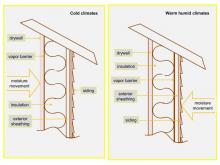 No matter how much insulation you install in your home and no matter how good it is, it's completely useless if it gets wet. To avoid moisture creeping into the insulation, you need to install a vapor barrier. The only exception to this is natural alternative insulation .
No matter how much insulation you install in your home and no matter how good it is, it's completely useless if it gets wet. To avoid moisture creeping into the insulation, you need to install a vapor barrier. The only exception to this is natural alternative insulation .
Passive solar homes are built to contain as much warm (or cool) air as possible and protect it from the outside environment. This means they are often tightly sealed, although they should have sufficient air exchange to be comfortable.
People living inside a sealed home, using washing machines, taking hot showers and even just breathing add moisture to the air. This moisture promotes the formation of mold and mildew on walls and in insulation – anywhere where there is a cooler surface, the moisture will try to condense. Mold can give rise to serious health issues as well as eating through window sills, sashes and other surfaces.
In most climates, there is more moisture inside the home than outside. The laws of physics demand that this moisture move towards a drier environment and, to do this, the moist air passes out of the house. It does this by travelling through any crack or crevice it can find in the walls and ceiling, around windows, in joins, around electrical outlets and anywhere else it can.
The problems come from the moisture in the air condensing. When the warm air passes through a wall and reaches the cool exterior wall or roof sheath, the water vapor condenses and makes the insulation damp. Damp insulation is a bad thing:
- The R-rating of most insulation drops significantly when it is damp: even a little moisture can reduce its effectiveness by as much as 50% (wool, rigid foam, rock wool and plastic bubble insulations are less susceptible).
- The condensation can collect inside the insulation, causing further efficiency reduction over time.
- Collected condensation can rot decking or sheathing: in the end, you may need to replace the entire roof or wall frame.
- Condensation in a ceiling can collect to the point where it drips down into living spaces or into the walls, causing even more destruction.
The simple solution to this problem is a vapor barrier . The barrier is placed on the side of the wall (or ceiling) facing the heaviest concentration of moisture (inside for most climates, outside for very humid climates) and stops the vapor-laden air from passing through the surface. This ensures that the air finds another route out of the house – one that has been planned and is designed to carry moisture to where it can be dispersed safely.